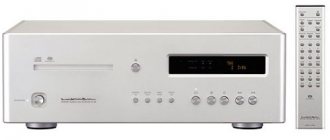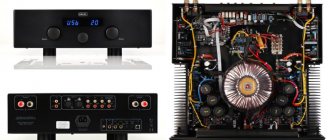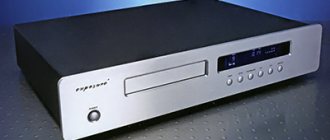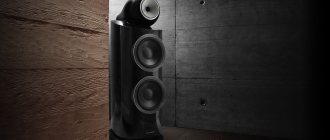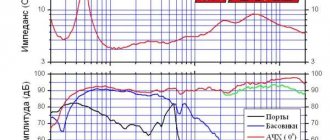Acoustics Audiovector
I think that this manufacturer is of interest to many music lovers and audiophiles, so I decided to open a separate topic on it.
Recently I became the owner of Audiovector Mi3 Signature floor standing speakers. Having searched the forum for information on them and on Audiovector in general, I found practically nothing, only something in topics about selling. The model is old, but the speakers are interesting, the speakers and tweeters are in excellent condition, the speakers have triwiring, they are very bassy, the top is very transparent, fast, they were a worthy replacement for my Jmlab Opal 615. Surprisingly, the speakers are not at all demanding on the distance from the wall, with they have two bass reflexes at the back. Moreover, the instructions for them say that they should be 20-40 cm from the wall. In 2006, the price for them in Europe was 3399 euros, which is very expensive.
Characteristics: Number of bands: 2.5 Type of acoustic design: Bass reflex Sensitivity, dB: 91 Nominal power, W: 275 Frequency range, Hz: 30-25000 Nominal input impedance, Ohm: 8 Height, mm: 1000 Width, mm: 200 Depth , mm: 320 Weight: 54 kg pair
a couple of photos from the Internet I would like the owners of this acoustics or a similar one from Audiovector to leave their reviews and share their operating experience, for example, how best to connect triwiring using biwiring. I settled on this scheme - HF and MF together, LF separately. Is it worth changing the standard jumpers, which are made of pure copper and plated with “gold”, for something else? Or this question - on the standard jumper between the midrange and bass sections there are a couple of small holes, why are they there? I also read that for better HF reproduction it is necessary to loosen the tweeter mounting screws, is anyone familiar with this topic? I read that Ole Klifoth himself uses Rotel for his acoustics, but surely there are other amplifiers that play well with it?
I think that brief information about the company will be of interest to regulars.
The Audiovector company was founded in Denmark back in 1979 by the talented Ole Klifoth, and to this day is considered an exclusive brand. The company's headquarters and production facilities are located in Copenhagen. The company has its own approach to development and offers truly unique acoustics. Until now, the assembly of acoustics takes place in Denmark; relatively recently, the assembly of cabinets was transferred to China, because, according to Ole Klifoth, the culture of furniture (cabinet) production is gradually being lost in Denmark, and the cost is very high compared to China. But everything else - speakers, tweeters, filters, including assembly and testing - is produced in Europe. Moreover, the entire assembly process is entrusted to one person, who then puts his signature on the column and is responsible for the quality of this particular specimen. A distinctive feature is that the company itself develops speakers and orders their production from leading manufacturers, for example, Scan-Speak, Focal, Vifa and Peerless. And Audiovector tweeters are designed and produced in-house, including the 2406 low-compression dome tweeter, released in 1984, and Avangarde ribbon tweeters based on a Hale driver. The official distributor in Russia is CTC CAPITAL, on their website you can find some reviews Official distributor of Audiovector in Russia
The company uses its technologies and concepts, including:
SEC is a technology implemented in low-compression tweeters with an open back and serves to expand the sound stage. A special port located at the rear diverts radiation from the rear of the tweeter. This radiation fades smoothly in the pipe, and the remaining signal becomes part of the room reflections. SEC creates a wider soundstage and better reproduction of detail with less distortion than systems with a conventional tweeter.
LCC - Low Compression Concept - a universal idea aimed at reducing all types of compression: in speakers, voice coils, high-frequency systems, inside cabinets and even in cables. This system allows all parts of the speakers to last almost forever, because mechanical stress and heat generation are significantly reduced. This allows Audiovector acoustics to sound freer, more dynamic and more powerful.
NES – no energy storage. This is a three-point fixation method that isolates the speaker from the mass of the cabinet. This design reduces distortion and sound coloration.
IUC - the ability to upgrade your speaker systems. All speaker models can be upgraded to the highest level, for example Signature to Avantgarde Arreté, or passive Supers can be turned into active Discreet Avantgarde.
Discreet are wireless active speaker systems. Almost all Audiovector loudspeaker systems are available in a Discreet version without passive filters, instead of which three digital amplifiers are installed with the distortion of even harmonics characteristic of tube amplifiers and Class A amplifiers. All passive speakers can be upgraded to Discreet.
A brief history of the Audiovector model ranges:
1979 Trapez was the first Audiovector loudspeaker to incorporate Ole Kleefott's designs. The model was an immediate success and received rave reviews from users and industry experts.
1985 The Audiovector 3, with its slanted front panel, was another design by Ole Kleefoth and Lars Mathijsen. It was followed by smaller versions - Audiovector 1 and 2, which followed the same design concept.
1996 The Audiovector M-series was the first truly modular series and marked the introduction of the IUC upgrade concept. The M-series also brought a high-frequency SEC system with non-compression tweeters.
1996 The IUC system is introduced. All Audiovector M-Series models can be upgraded to the highest level. They were later updated to the Mi level and then again to the Mi-SE level.
1998 The Avantgarde AMT tweeter is designed with an open back design. Ideal for SEC concept, with a frequency range of 2kHz-50kHz. It has ultra-low distortion and very fast response.
2001 The S6 brought with it the famous teardrop-shaped hulls with a complete absence of standing waves. The perfect combination of beautiful design and functionality.
2004 The S-series is born, based on the shape of the S6. Floorstanding and bookshelf speakers, a center channel and a subwoofer form a complete line-up for both stereo and surround sound.
2008 The Avangarde AMT tweeter has been brought to the highest level. Faster transient response, even flatter frequency response and reduced distortion result in cleaner, clearer sound.
2010 The R11 Arreté model has been released - the most expensive Danish speakers to date. Originally intended for use as reference speaker systems.
2011 The S6 model evolved into the Si6. They were soon recognized as truly reference acoustics. They use an isobaric low-frequency system combined with a 2.5-way bass/mid-bass/treble connection.
2012 Audiovector Discreet active speakers presented. High sound quality was ensured by the ultra-high damping coefficient of PWM digital amplifiers with analog sound, DSP control with electronic crossovers and phase-linear Bessel filters.
2014 SR-series output: compact acoustics from Audiovector with the best characteristics to date. New high-frequency drivers, low-loss crossovers, three-point NES mounting system and multiple finishes.
Audiovector: Ole Klifot, review. Magazine "WHAT HI-FI?"
“There are a lot of little things that we take very seriously.”
Save and read later -
Ole Klifot, founder and chief developer of Audiovector (Denmark), shares with us recipes for creating musical-sounding speakers.
Is there any main idea in the design of Audiovector speakers that distinguishes them from products from other manufacturers?
— There are two main points in acoustics. The first is when electrical vibrations turn into mechanical vibrations, the second is when the movement of the speaker creates an acoustic wave in the room.
Our Low Compression concept is responsible for the first. We believe that the cone should move as freely as possible in order to accurately reproduce the waveform coming from the amplifier. In this case, less energy is converted into heat, which means that such an emitter is more efficient and better reproduces both quiet and loud fragments. It's very easy to choose the right amplifier for Audiovector, and with them you can listen to any music, from Bach to Rammstein. I have jazz recordings from the 30s in my collection - the technical quality, of course, is terrible, but on our speakers they still sound better than on others. I also forgot to mention reliability: because the speakers move freely, they don't overheat and are very difficult to burn out - of the 60,000 units installed in our budget Ki series, we have yet to replace a single one.
The second concept concerns the interaction between the speakers and the room. For example, in our Ki series floorstanders we use a folded, reverse horn, which allows us to get high efficiency and free dynamics from speakers the width of a CD case. And in the Si series speakers you can see an additional hole on the back side, through which the radiation from the rear side of the tweeter comes out and, reflecting from the back wall, forms a wider stage. This is our second key principle: Soundstage Enhancement Concept. We also have a proprietary upgrade program - Individual Upgrade Concept, which rather relates to the field of psychology. All models are available in four modifications (budget versions in two); you can upgrade your speaker system to a more advanced version over time. This way you always have room to move forward.
Do you use your own speakers?
— Yes, the speakers are developed by me and two other engineers from Peerless and ScanSpeak, then they are manufactured according to our specifications. The advantage of this approach is that we can, for example, make a midrange head with an upper cut-off frequency of 3 kHz and a natural roll-off of 18 dB/octave. By adding just one filter element in the crossover, we get a slope of 24 dB/octave, which is optimal for matching with the tweeter in terms of vertical directivity. Plus minimal crossover losses and phase distortion. Most of our speakers operate with simple first order filters. There are other nuances. For example, we are confident that the three-point speaker mounting system is better than any other at isolating them from the cabinet. By the way, here the engineers from the companies that produce speakers do not agree with me, but I order what I think is necessary.
What materials do you think are best for a diffuser?
— We glue a sheet of glass-carbon fiber onto a paper base using a very light glue - such a diffuser is very light and has optimal damping. The material of the coil frame is very important; some non-metallic materials (for example, fiberglass) do not remove heat well, others (Kapton) are not rigid enough, and aluminum ones have weak interaction with the magnet field, creating resistance to movement. Therefore, we began to use titanium - clear experience demonstrates its advantage: you release a coil with the same mass on an aluminum and titanium base into the gap, the latter sinks faster and more smoothly.
Why don't you use metal diffusers?
— Oh, we tried many times (I have samples of all commercially produced materials), but we came to the conclusion that such speakers sound less musical. In a certain range, the diffuser moves strictly like a piston, but starting from a certain frequency, stability is lost and strong resonances arise. You can shift this frequency beyond the audio range, say to 25 kHz for a midrange speaker, but you will still hear a characteristic overtone in the music, and studies with a short pulse will allow you to see the “ringing”. Perhaps in the future we will use metals, but only for bass drivers.
If we follow your concept, we probably need to abandon the ferromagnetic fluid in the gap of the HF speakers?
— I would like to, but it’s not possible, because without it the speaker will overheat. But we found a solution. Most manufacturers use a fluid with a viscosity of 1000 ppm (it is similar to oil), and we fill the gap with a fluid with a viscosity of 55 ppm (slightly thicker than the tea that we drink), as a result, the speed and dynamic characteristics are practically not affected.
Do you use coreless coils in your filters?
- Not always. If we are talking about obtaining large inductance, a lot of wire will have to be used in a coreless coil, which will increase active losses. Therefore, we use a composite material made from a mixture of ferrite and sand, which has almost the same linearity as an air core, but allows you to wind less wire. We listened to these reels and found out that they are really good. We also select capacitors by ear: some sound a little dry, some “tinkle.” In addition, in top versions we use cryogenic treatment of coils, wires and terminals. This is, in general, a well-known method to make the sound more harmonious.
What cables are used for internal wiring?
- This is our own development (we currently offer it as a separate product) with an asymmetrical design - the cross-section of the positive core is larger than the cross-section of the negative one. The pluses of the terminals are connected with a thick wire directly to the positive terminals of all speakers, and the crossover elements are located in the negative branch. This allows the absolute phase of the signal to be correctly transmitted. As far as we know, you even have versions with an active crossover.
— Yes, the amplification part was developed by Nairn. In general, I consider powered speakers to be the best solution in terms of transparency and dynamics and always keep their sound in mind when designing new speakers.
Why don't you use - even in subwoofers - a closed enclosure, which many consider to be the best in terms of impulse response?
— Formally closed packages provide better transient characteristics, but this comes at the cost of reduced efficiency. In such a case it is difficult for the speaker to breathe, and we try to provide it with maximum freedom. In subwoofers we use a muted bass reflex, which allows excess energy to escape, while at the same time providing the necessary control. A particularly difficult task was when designing wall-mounted and built-in speakers, for which I invented a rather strange port made of a felt panel with holes.
Tell us more about your built-in speakers. Can they without stretch be classified as High End?
— In short, we decided to make speakers with a sound that is completely uncharacteristic for a “built-in” sound. The problem is that speakers generally sound better in free space - when you push them up against a wall, the soundstage becomes flat. I thought about this and came to the conclusion that in wall acoustics, unlike conventional ones, it is necessary to use emitters not with a wide, but with a narrow directivity pattern (for this we used; dual emitters not with a wide, but with a narrow directivity diagram (for this we used dual emitters) to avoid early reflections from the wall. In addition, for some reason many companies do not take such acoustics seriously, so the cheapest materials are used. We decided not to focus on price, but to try to do everything as competently as possible in terms of sound. And it worked. So far our wall-mounted speakers are selling better than built-in ones, but in a number of countries, for example Italy, speakers are preferred to be built in. We cooperate with NaimNet, they install our speakers in serious multi-room systems.
Where are Audiovector speakers assembled?
“All models from the affordable Ki series to the flagship SR6 are assembled at our factory in Copenhagen. The cabinets come ready-made from China: unfortunately, we have lost the culture of carpentry, and today in Denmark it is increasingly difficult to make good furniture. Some parts come from Asian countries, others we purchase directly from Scandinavian companies. But we collect everything ourselves, since this allows us to observe all the details. You see, it is not enough to design a good column; it is important to achieve its repeatability in mass production. For example, we carefully calculate the composition, density and location of application of sound-absorbing material - although many do not pay attention to this. Meanwhile, this is very important - it has the ability to accumulate mechanical energy and release it with a delay. There are a lot of weird little things that we take very seriously - that's probably Audiovector's big secret.
Prepared based on materials from the magazine “WHAT HI-FI?”, January 2011
www.whathifi.ru
This article has been read 13,880 times
The article is included in the sections:
Hi-Fi manufacturers. Stories and interviews



